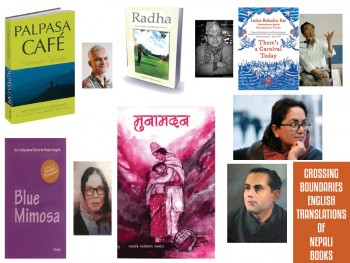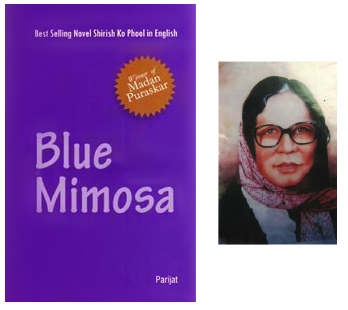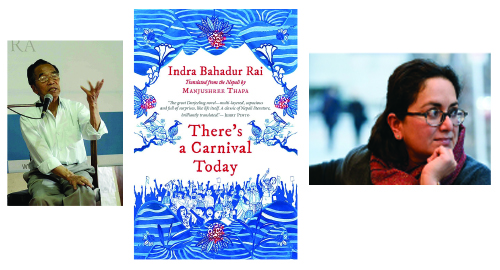Crossing Boundaries : English Translations of Nepali Books

 Muna Madan by Laxmi Prasad Devkota
Muna Madan by Laxmi Prasad Devkota
There are very few who haven’t heard of Devkota’s finest work, the Muna Madan. A short epic about Muna and Madan, this poem is widely read in Nepali but it’s English translation is just as popular. The poem narrates the story of Madan, a poor farmer who decides to go to Tibet as a merchant to earn money leaving his aging mother and newlywed wife, Muna behind. Muna begs her husband to stay however, Madan leaves in hopes of earning riches for the family. The poem is a tragic telling of the hardships that both Muna and Madan face in anticipation of reuniting with each other. Although a short epic, Muna Madan has become commercially successful and is considered as a masterpiece in Nepali literature.
Blue Mimosa by Parijat
One of the most well known Nepali books that have been translated for international readers, The Blue Mimosa is the English version of the well-known book, Sirish ko Phool by Bishnu Kumari Waiba, better known as Parijat. The book is a very short novel about a man who returns from World War II, torn and unhappy who then turns to alcohol to drown his emptiness. He befriends another alcoholic and becomes close to the friend’s three sisters, falling in love with the middle sister who is headstrong and stubborn in her own ways. This tragic novel is considered to be one of the first Nepali novels to gain international recognition.
English version of the well-known book, Sirish ko Phool by Bishnu Kumari Waiba, better known as Parijat. The book is a very short novel about a man who returns from World War II, torn and unhappy who then turns to alcohol to drown his emptiness. He befriends another alcoholic and becomes close to the friend’s three sisters, falling in love with the middle sister who is headstrong and stubborn in her own ways. This tragic novel is considered to be one of the first Nepali novels to gain international recognition.
 Radha by Krishna Dharabhasi
Radha by Krishna Dharabhasi
Relatively lesser known compared to the other books on this list, Radha is yet an epic in its own right. Based on the Sanskrit epic, Mahabharat, “Radha” is an adaptation of the story where, Radha, the lover of the Hindu god, Krishna is in the main lead. Although Radha is a prominent character in the tale of Krishna, she has been ignored in the Mahabharat. However, Dharabhasi’s Radha represents her as a brave, dignified and revolutionary soul. This story metaphorically represents Nepal during the time of the Maoist People’s War.
There’s a Carnival Today/ Aaja Ramita Chha by Indra Bahadur Rai, Translated by Manjushree Thapa
A story set in the 1950’s in a post-independence India, There’s a Carnival Today revolves around the incidences of Janakman Yonzon, a businessman and local leader living in Darjeeling. As the fragile and unstable political situation begins to affect the local governing individuals and protests occur, Janak is faced with situations beyond his control. The novel shadows real-life incidents such as the tea-estate labor protest and Darjeeling’s movement to create a separate state, Gorkhaland. Translated expertly by Manjushree Thapa, an accomplished writer in her own right, There’s a Carnival Today is a modern classic in Nepali literature that originates from India about identity and political transition.
Palpasa Café by Narayan Wagle
 First published in 2005, Palpasa Café became an instant favorite to readers, young and old alike. The novel was translated into English in 2008 and is one of the rare Nepali books that have been translated even beyond English into Korean and French. The novel is about the protagonist Drishya, an artist living in Kathmandu and Palpasa, a first generation American-Nepali as they travel through the country during the Maoist insurgency in Nepal. The protagonist goes through a series of incidences where both he and Palpasa develop strong feelings for each other. Vividly portraying how the Maoist insurgency-affected lives of Nepalis, both in and outside the country, Palpasa Café is a good read for anyone who wants a good understanding of the country’s recent past, no matter where their roots lie.
First published in 2005, Palpasa Café became an instant favorite to readers, young and old alike. The novel was translated into English in 2008 and is one of the rare Nepali books that have been translated even beyond English into Korean and French. The novel is about the protagonist Drishya, an artist living in Kathmandu and Palpasa, a first generation American-Nepali as they travel through the country during the Maoist insurgency in Nepal. The protagonist goes through a series of incidences where both he and Palpasa develop strong feelings for each other. Vividly portraying how the Maoist insurgency-affected lives of Nepalis, both in and outside the country, Palpasa Café is a good read for anyone who wants a good understanding of the country’s recent past, no matter where their roots lie.
